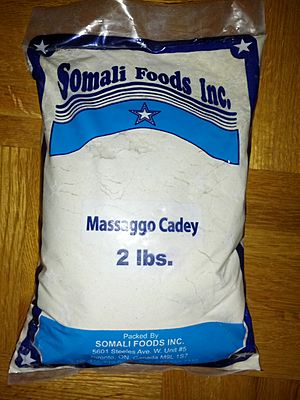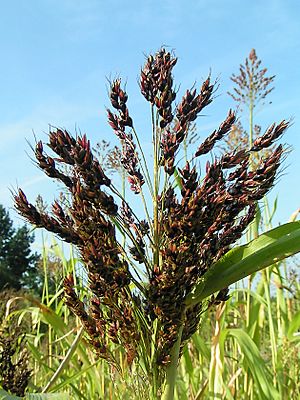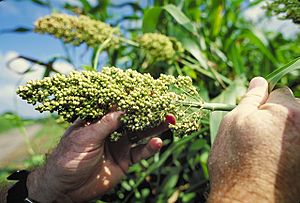Commercial sorghum facts for kids
Commercial sorghum is a type of grass grown for its grain, fiber, and as food for animals. These plants grow well in warm parts of the world, especially in Africa and Asia, where they originally came from.
Sorghum has many other names, like durra, Egyptian millet, jowar, milo, and great millet.
For hundreds of years, sorghum has been a very important food for millions of people in dry, warm areas of Asia and Africa. In some poorer parts of the world, it's still a main source of energy, protein, vitamins, and minerals. Sorghum can grow in tough places where other crops struggle, much like cassava. Farmers often grow it without needing special fertilizers.
Grain sorghum is the third most important cereal crop in the United States and the fifth most important worldwide. In 2010, Nigeria grew the most grain sorghum, followed by the U.S. and India. In many countries, sorghum is mostly used to feed chickens and cattle. The main countries that export sorghum are the U.S., Australia, and Argentina. Mexico is the biggest buyer.
Scientists and farmers are working together to make sorghum farming even better. Organizations like the International Crops Research Institute for the Semi-Arid Tropics (ICRISAT) have helped create new types of sorghum. These new varieties have led to much higher yields, especially in India. This means farmers can grow more food and even try growing other valuable crops, improving their lives.
Contents
Where Did Sorghum Come From?

The wild relatives of sorghum mostly grow in Africa, south of the Sahara Desert. This suggests that sorghum was first grown there by people. Even though we don't have all the ancient details, early signs of domesticated sorghum have been found in India and Pakistan. This means sorghum likely traveled from East Africa to the Indian subcontinent a very long time ago. Other African crops, like pearl millet and cowpeas, also show similar travel patterns.
Most types of sorghum grown today came from Africa, where they grew in grassy areas called savannas. During a time of great agricultural growth in the Middle East and North Africa, sorghum was planted widely. The name "sorghum" comes from an Italian word, which means "grain of Syria."
Sorghum arrived in the Middle East later than some other crops. It wasn't known in the Mediterranean area until Roman times. By the 900s AD, it was widely grown in Iraq and became a main food in parts of Persia (modern-day Iran). From there, it spread to Egypt and later to Islamic Spain. From Spain, it was brought to Christian Spain and then France by the 1100s. In the Muslim world, sorghum was often grown in places where the soil was poor or the weather was too hot and dry for other crops.
Sorghum is great at growing in hot, dry, or semi-dry places. There are four main types:
- Grain sorghums: Used for food.
- Grass sorghums: Used for animal pasture and hay.
- Sweet sorghums: Used to make sorghum syrup.
- Broom corn: Used for human food and making brooms.
Sweet sorghum varieties are known for being sweet and juicy.
How Sorghum Is Grown and Used

Sorghum is used for food, animal feed, and to make alcoholic drinks. It can handle dry and hot weather, which makes it very important in dry regions. It's a key food crop in Africa, Central America, and South Asia. It's known as the "fifth most important cereal crop grown in the world."
Sorghum as Animal Feed
The FAO reported that in 2004, about 440,000 square kilometers (170,000 square miles) of land were used to grow sorghum worldwide. In the U.S., sorghum grain is mainly used to feed livestock, like cattle, as a substitute for corn. This is because their nutritional values are very similar. Some types of sorghum grown for feed have special compounds that stop birds from eating them. These types need extra processing so cattle can digest them easily.
Sorghum Production Around the World
In 2019, the United States was the top producer of sorghum, harvesting 8.7 million metric tons. The next biggest producers were Nigeria, Ethiopia, and Mexico. Other major sorghum-growing regions include Australia, Brazil, China, and India.
In the future, more sorghum might be grown in Tanzania. Farmers there are starting to grow it instead of corn because it can handle droughts better, which is important with changing weather. The Tanzanian government is even helping farmers get improved sorghum seeds and fertilizer. Farmers say these new types of sorghum grow fast, need less work, and are stronger against pests and diseases.
In 2010, the world harvested 55.6 million metric tons of sorghum. The average yield was 1.37 metric tons per hectare. The most productive sorghum farms were in Jordan, with an average of 12.7 metric tons per hectare. In the U.S., the average was 4.5 metric tons per hectare.
While the amount of land used for sorghum has gone down, the amount of sorghum grown per hectare has gone up. The largest sorghum harvest since 1972 was in 1985, with 77.6 million metric tons.
Cooking with Sorghum
In dry, less developed parts of the world, sorghum is a crucial food crop, especially for farmers who grow food just for themselves and their families. It's used to make foods like couscous, sorghum flour, porridge, and molasses.
In many parts of India, like Maharashtra and Karnataka, a type of flatbread called Bhakri (or jolada rotti) is a main food. It's usually made from sorghum. In other areas, roti (jonna rotte) made with sorghum is also a staple.
In South Africa, sorghum flour is often made into a thick porridge called mabele. It can be served with sour milk or cooked greens.
In Ethiopia, sorghum is fermented to make injera flatbread, and in Sudan, it's used for kisra. Sometimes, dosa in India is made with sorghum, but rice is more common.
In the southern United States, sorghum syrup used to be a popular sweet topping for biscuits, cornbread, and pancakes. It's not as common today.
In Arab cuisine, whole sorghum grains are often cooked into couscous, porridges, soups, and cakes. Many people use sorghum flour, mixed with other flours, to make bread. The seeds and stalks are fed to cattle and poultry. Some types of sorghum have been used for roofs, fencing, baskets, brushes, and brooms. The stalks can also be used as fuel.
Sorghum seeds can be popped just like popcorn, using oil or hot air. The popped kernels are smaller than popcorn.
Sorghum is sometimes used to make tortillas, for example, in Central America. In El Salvador, they might use sorghum (maicillo) for tortillas if there isn't enough corn.
Since 2000, sorghum has become more popular in homemade and store-bought breads and cereals for people who follow a gluten-free diet.
Sorghum in Drinks
In China, sorghum is the most important ingredient for making strong alcoholic drinks like maotai and kaoliang wine.
Sorghum Beer
In southern Africa, sorghum is used to make beer. Recently, sorghum has also been used to make gluten-free beer for people who can't eat gluten. Sorghum is prepared like barley to create a "malt" that can be used to brew beer without gluten.
In 2006, Anheuser-Busch in the U.S. launched "Redbridge" beer, which is gluten-free and uses sorghum as its main ingredient.
African sorghum beer is usually brownish-pink with a fruity, sour taste. Its alcohol content can be from 1% to 8%. This beer has a lot of protein, which helps it create a foamy, milk-like top. Because it's not filtered, it looks cloudy and might have bits of grain. People say it's very good for quenching thirst, even though it's usually drunk at room temperature.
African sorghum beer is very popular, especially among the black community, for historical reasons. It became popular in South Africa partly because it was allowed during a time when other alcoholic drinks were forbidden for black people.
Sorghum beer is called bjala in northern Sotho. It's traditionally made to celebrate special events, like unveiling a loved one's tombstone. Women in the community usually make the beer. The process starts days before the event, with women boiling sorghum and water in large pots. After fermenting for several days, it's strained, which takes a lot of effort. Sorghum beer has many names across Africa, including Umqombothi (South Africa), burukuto (Nigeria), pombe (East Africa), and bil-bil (Cameroon). African sorghum beer is made using both lactic acid fermentation (which gives it the sour taste) and alcoholic fermentation.
The main steps to make African sorghum beer are: malting (preparing the grain), mashing (mixing with water), souring, and alcoholic fermentation. The souring step, which uses lactic acid fermentation, gives the beer its unique sour taste. This can be started with yogurt or other natural starters.
Commercial African sorghum beer is sold while it's still active with fermentation. This means special containers with vents are used to let gas escape. While spoilage can be a concern, the active fermentation also helps keep the product safe by creating competition among microorganisms.
Other Uses for Sorghum
Sorghum straw (the stems) can be used to make strong wallboard for building houses. It's also used for packaging materials that are good for the environment and don't create static electricity, which is useful for sensitive electronics.
Not much research has been done to improve sorghum plants because most of it is grown by small farmers. This means the crop is often limited by insects, diseases, and weeds, rather than by the plant's own growth potential. To help sorghum grow better in dry areas, more money would be needed to control pests and improve farming methods.
In 2005, the U.S. government set a goal to produce billions of liters of ethanol (a type of fuel) from renewable sources by 2012. Currently, about 12% of the grain sorghum grown in the U.S. is used to make ethanol.
Some reports suggest that ethanol made from sorghum sap (the sweet liquid inside the plant) can produce four times more energy than corn-based ethanol, similar to sugarcane.
Growing Grain Sorghum
| 12.0 million | |
| 9.3 million | |
| 7.1 million | |
| 6.6 million | |
| 3.9 million | |
| 3.1 million | |
| 2.9 million | |
| 2.5 million | |
| 2.3 million | |
| 2.0 million | |
| World Total | 65.5 million |
Sorghum needs an average temperature of at least 25°C (77°F) to grow the most grain. It grows best when daytime temperatures are at least 30°C (86°F). If night temperatures drop below 13°C (55°F) for several days, it can greatly reduce how much grain the plant produces. Sorghum can't be planted until the soil temperature reaches 17°C (63°F). It needs a long growing season, usually 90–120 days, so planting it early enough is important.
Grain sorghum is usually planted using a machine similar to a corn planter. It's planted about 2–5 cm (1–2 inches) deep, depending on how dense the soil is. The goal is to have 50,000 to 300,000 plants per hectare (about 20,000 to 120,000 plants per acre) in good soil.
Farmers have found that planting sorghum in narrow rows (about 25 cm or 10 inches apart) instead of wide rows (about 1 meter or 3 feet apart) can increase yields by 10–15% when there's enough water and sunlight.
Sorghum is a very strong plant and competes well with weeds, especially in narrow rows. It produces a natural chemical called sorgoleone, which helps fight off weeds. This chemical is so effective that it can sometimes stop other crops from growing in the same field later. Scientists are working to find the genes responsible for this chemical. This could help them create sorghum types that don't leave harmful chemicals in the soil, or even help other crops produce their own natural pesticides.
Insects and diseases are not a big problem for sorghum crops. However, birds can cause a lot of grain loss. Farmers try to fight birds by growing types of sorghum with more tannins (a bitter substance) and by planting very large fields of sorghum. The crop can also be attacked by corn earworms, aphids, and some types of Lepidoptera larvae (caterpillars).
Sorghum needs a lot of nitrogen to grow well. An average hectare producing 6.3 metric tons of grain needs about 110 kg (243 lbs) of nitrogen. It needs much smaller amounts of phosphorus and potassium.
Sorghum grows similarly to corn but has more side shoots and a larger, more branched root system. Its roots can go down up to 1.2 meters (4 feet) deep. The plant gets most of its water from the top meter of soil. Because of this, in dry areas, the amount of grain produced can be greatly affected by how well the soil holds water. In its early stages, sorghum needs about 70–100 mm (2.75–4 inches) of water every 10 days. As it grows and its roots go deeper, it needs less water. By the time the seeds are forming, it needs about 50 mm (2 inches) every 10 days. Hard soil or shallow topsoil can make it harder for the plant to deal with dry conditions because its roots can't grow deep enough. Since these plants are made for hot, dry places, it's important to keep the soil loose and grow them in good topsoil.
Wild sorghum plants can grow very tall, about 1.5–2 meters (5–6.5 feet). But because tall plants were hard to harvest, farmers have chosen types with genes for dwarfism in recent years. Now, most sorghum grows to about 60–120 cm (2–4 feet) tall.
Sorghum yields are not as badly affected by short dry periods as other crops like corn. This is because sorghum develops its seed heads over a longer time. Short periods of water stress usually don't stop the seeds from forming. Even in a long, severe drought, sorghum will usually still produce some seeds, even if they are smaller. It's rare for sorghum to have no seeds at all, even in very dry conditions. Sorghum's ability to grow with less water than corn might be because it holds water in its leaves better. Sorghum has a waxy coating on its leaves and stems that helps keep water inside the plant, even in intense heat.
Sorghum Nutrition

Sorghum is about 70% starch, making it a good source of energy. Its starch is mostly made of a complex sugar called amylopectin (70-80%) and a simpler one called amylose (20-30%).
When raw, sorghum starch is not easily digested, only about 33-48%. But processing the grain by steaming, pressure cooking, flaking, or puffing makes it much easier to digest. This happens because the starch particles are released from their protein covering, allowing digestive enzymes to reach them better.
When cooked, the starch in sorghum tends to become less soluble and more solid again as it cools. This process is called retrogradation. It happens more easily at low temperatures and when there's a lot of starch.
Some types of sorghum contain substances called tannins, which can make it harder to digest the starch. Cooking sorghum in moist, hot conditions helps reduce these tannins.
Sorghum starch does not contain gluten. This makes it a good grain for people who are sensitive to gluten.
After starch, proteins are the main part of sorghum. The amount of important amino acids in sorghum protein can vary depending on the type of sorghum, the soil, and how it's grown. Some studies show that certain parts of sorghum protein have good amounts of important amino acids like lysine and tryptophan. However, other studies suggest that another part of the protein is very low in these important amino acids. How well sorghum protein is digested also varies, from 30% to 70%.
A World Health Organization report suggests that the common types of sorghum eaten in poorer countries might not provide enough nutrients for babies and young children to grow properly. The report also said that sorghum alone might not be enough for adults to stay healthy. A balanced diet would need to include other foods along with sorghum.
Sorghum also has several minerals. These minerals are not spread evenly and are more concentrated in the germ and the outer layer of the seed. When sorghum flour is milled (ground), minerals like phosphorus, iron, zinc, and copper decrease if more of the outer layer is removed. Similarly, removing the fibrous outer layer of the grain greatly reduces its mineral content. The presence of tannins in sorghum also reduces how well the body can use its minerals. It's important to process and prepare sorghum properly to improve its nutritional value.
Sorghum is a good source of B-complex vitamins. Some types of sorghum have beta-carotene, which the human body can turn into vitamin A. However, because carotenes are sensitive to light and vary with growing conditions, scientists believe sorghum is probably not a major source of vitamin A. Some fat-soluble vitamins (D, E, and K) have also been found in sorghum grain, but not in large enough amounts to be a main source. Sorghum, as it's usually eaten, is not a source of vitamin C.
How Sorghum Compares to Other Main Foods
The table below shows the nutrients in raw sorghum compared to other major staple foods. Remember, these foods are not eaten raw; they must be cooked. The nutritional value changes a lot after cooking, depending on how they are prepared (boiled, baked, steamed, fried, etc.).
| Staple | Maize (corn)[A] | Rice, white[B] | Wheat[C] | Potatoes[D] | Cassava[E] | Soybeans, green[F] | Sweet potatoes[G] | Yams[Y] | Sorghum[H] | Plantain[Z] | RDA |
|---|---|---|---|---|---|---|---|---|---|---|---|
| Water content (%) | 10 | 12 | 13 | 79 | 60 | 68 | 77 | 70 | 9 | 65 | |
| Raw grams per 100g dry weight | 111 | 114 | 115 | 476 | 250 | 313 | 435 | 333 | 110 | 286 | |
| Nutrient | |||||||||||
| Energy (kJ) | 1698 | 1736 | 1574 | 1533 | 1675 | 1922 | 1565 | 1647 | 1559 | 1460 | 8,368–10,460 |
| Protein (g) | 10.4 | 8.1 | 14.5 | 9.5 | 3.5 | 40.6 | 7.0 | 5.0 | 12.4 | 3.7 | 50 |
| Fat (g) | 5.3 | 0.8 | 1.8 | 0.4 | 0.7 | 21.6 | 0.2 | 0.6 | 3.6 | 1.1 | 44–77 |
| Carbohydrates (g) | 82 | 91 | 82 | 81 | 95 | 34 | 87 | 93 | 82 | 91 | 130 |
| Fiber (g) | 8.1 | 1.5 | 14.0 | 10.5 | 4.5 | 13.1 | 13.0 | 13.7 | 6.9 | 6.6 | 30 |
| Sugar (g) | 0.7 | 0.1 | 0.5 | 3.7 | 4.3 | 0.0 | 18.2 | 1.7 | 0.0 | 42.9 | minimal |
| Minerals | [A] | [B] | [C] | [D] | [E] | [F] | [G] | [Y] | [H] | [Z] | RDA |
| Calcium (mg) | 8 | 32 | 33 | 57 | 40 | 616 | 130 | 57 | 31 | 9 | 1,000 |
| Iron (mg) | 3.01 | 0.91 | 3.67 | 3.71 | 0.68 | 11.09 | 2.65 | 1.80 | 4.84 | 1.71 | 8 |
| Magnesium (mg) | 141 | 28 | 145 | 110 | 53 | 203 | 109 | 70 | 0 | 106 | 400 |
| Phosphorus (mg) | 233 | 131 | 331 | 271 | 68 | 606 | 204 | 183 | 315 | 97 | 700 |
| Potassium (mg) | 319 | 131 | 417 | 2005 | 678 | 1938 | 1465 | 2720 | 385 | 1426 | 4700 |
| Sodium (mg) | 39 | 6 | 2 | 29 | 35 | 47 | 239 | 30 | 7 | 11 | 1,500 |
| Zinc (mg) | 2.46 | 1.24 | 3.05 | 1.38 | 0.85 | 3.09 | 1.30 | 0.80 | 0.00 | 0.40 | 11 |
| Copper (mg) | 0.34 | 0.25 | 0.49 | 0.52 | 0.25 | 0.41 | 0.65 | 0.60 | - | 0.23 | 0.9 |
| Manganese (mg) | 0.54 | 1.24 | 4.59 | 0.71 | 0.95 | 1.72 | 1.13 | 1.33 | - | - | 2.3 |
| Selenium (μg) | 17.2 | 17.2 | 81.3 | 1.4 | 1.8 | 4.7 | 2.6 | 2.3 | 0.0 | 4.3 | 55 |
| Vitamins | [A] | [B] | [C] | [D] | [E] | [F] | [G] | [Y] | [H] | [Z] | RDA |
| Vitamin C (mg) | 0.0 | 0.0 | 0.0 | 93.8 | 51.5 | 90.6 | 10.4 | 57.0 | 0.0 | 52.6 | 90 |
| Thiamin (B1) (mg) | 0.43 | 0.08 | 0.34 | 0.38 | 0.23 | 1.38 | 0.35 | 0.37 | 0.26 | 0.14 | 1.2 |
| Riboflavin (B2) (mg) | 0.22 | 0.06 | 0.14 | 0.14 | 0.13 | 0.56 | 0.26 | 0.10 | 0.15 | 0.14 | 1.3 |
| Niacin (B3) (mg) | 4.03 | 1.82 | 6.28 | 5.00 | 2.13 | 5.16 | 2.43 | 1.83 | 3.22 | 1.97 | 16 |
| Pantothenic acid (B5) (mg) | 0.47 | 1.15 | 1.09 | 1.43 | 0.28 | 0.47 | 3.48 | 1.03 | - | 0.74 | 5 |
| Vitamin B6 (mg) | 0.69 | 0.18 | 0.34 | 1.43 | 0.23 | 0.22 | 0.91 | 0.97 | - | 0.86 | 1.3 |
| Folate Total (B9) (μg) | 21 | 9 | 44 | 76 | 68 | 516 | 48 | 77 | 0 | 63 | 400 |
| Vitamin A (IU) | 238 | 0 | 10 | 10 | 33 | 563 | 4178 | 460 | 0 | 3220 | 5000 |
| Vitamin E, alpha-tocopherol (mg) | 0.54 | 0.13 | 1.16 | 0.05 | 0.48 | 0.00 | 1.13 | 1.30 | 0.00 | 0.40 | 15 |
| Vitamin K1 (μg) | 0.3 | 0.1 | 2.2 | 9.0 | 4.8 | 0.0 | 7.8 | 8.7 | 0.0 | 2.0 | 120 |
| Beta-carotene (μg) | 108 | 0 | 6 | 5 | 20 | 0 | 36996 | 277 | 0 | 1306 | 10500 |
| Lutein+zeaxanthin (μg) | 1506 | 0 | 253 | 38 | 0 | 0 | 0 | 0 | 0 | 86 | 6000 |
| Fats | [A] | [B] | [C] | [D] | [E] | [F] | [G] | [Y] | [H] | [Z] | RDA |
| Saturated fatty acids (g) | 0.74 | 0.20 | 0.30 | 0.14 | 0.18 | 2.47 | 0.09 | 0.13 | 0.51 | 0.40 | minimal |
| Monounsaturated fatty acids (g) | 1.39 | 0.24 | 0.23 | 0.00 | 0.20 | 4.00 | 0.00 | 0.03 | 1.09 | 0.09 | 22–55 |
| Polyunsaturated fatty acids (g) | 2.40 | 0.20 | 0.72 | 0.19 | 0.13 | 10.00 | 0.04 | 0.27 | 1.51 | 0.20 | 13–19 |
| [A] | [B] | [C] | [D] | [E] | [F] | [G] | [Y] | [H] | [Z] | RDA |



